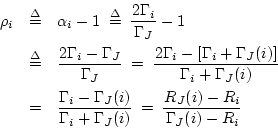Physically, the reflection coefficient seen at port ![]() is due to an
impedance step from
is due to an
impedance step from ![]() , that of the port interface, to a new
impedance consisting of the parallel combination of all other
port impedances meeting at the junction. Let
, that of the port interface, to a new
impedance consisting of the parallel combination of all other
port impedances meeting at the junction. Let
Let's check this ``physical'' derivation against the formal definition
Eq. (N.20) leading to
![]() in Eq. (N.22).
Toward this goal, let
in Eq. (N.22).
Toward this goal, let


and the result is verified.